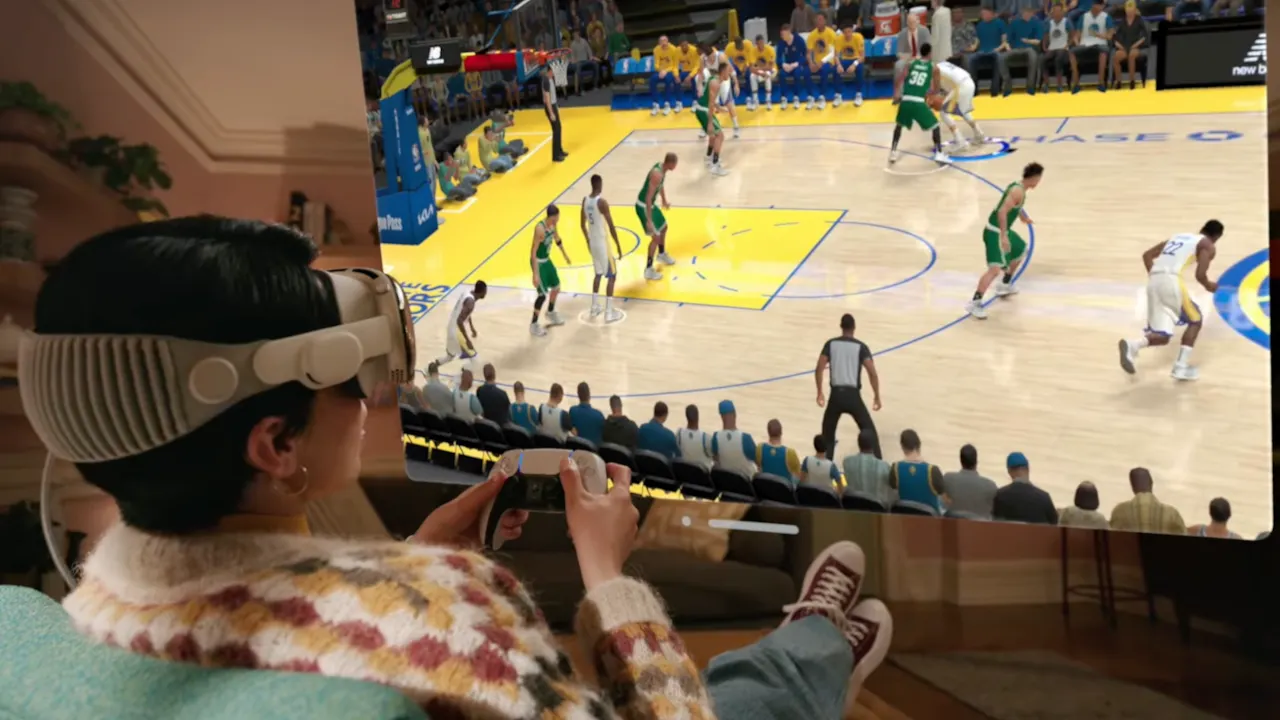Apple revealed the long-awaited Vision Pro augmented reality (AR) headset today, and spent considerable time detailing the hardware, software, and use cases of the $3,499 device. But one thing that Apple barely mentioned today is gaming.
During the presentation, Apple only specifically showed gaming in action just once: pointing out that the headset supports existing Apple Arcade games, which means it’ll play games that were originally designed for iPhones and iPads, plus are playable on Mac and Apple TV.
In fact, Apple only showed the mobile version of NBA 2K23 Arcade Edition, a streamlined mobile basketball sim. During the presentation, we see someone play the game on a virtual floating screen while using a PlayStation 5 DualSense gamepad.
Apple says that over 100 of its Apple Arcade games will be made compatible by the time the Vision Pro reaches consumers in early 2024, representing about half of the total iOS lineup in Apple’s subscription service. Other notable Apple Arcade games on iOS include Disney Melee Mania, Crossy Road+, Sonic Racing, and Lego Builder’s Journey.
There are great games in the Apple Arcade portfolio. Furthermore, Apple showed a grid of existing iOS apps that will be ported to the device, including Candy Crush Saga and Myst Mobile. Again, though, these will likely playable on digital screens or windows virtually positioned in front of you.
We did see a few potentially more immersive games listed during a quick demo of the visionOS App Store, including Game Room—which includes classic chess and dice games—plus Super Fruit Ninja and a port of Rec Room, a Roblox-like platform with user-created VR games. But those weren’t demonstrated, just spotted in the App Store interface.
From what Apple has shown so far, its initial gaming focus for the Vision Pro primarily revolve around developers porting existing games played on flat screens—and largely casual ones in nature—despite it being a device that’s built for full 3D immersion.
Where’s the games?
Apple didn’t show any fully immersive VR games like you’ll find on the Meta Quest 2 or PC-based VR headsets. Perhaps more surprisingly, it didn’t showcase any original augmented reality games that merge the real and digital worlds for new kinds of experiences.
Disney’s brief segment during the presentation hinted at potential use cases—including the ability to generate a Disney World parade on your kitchen countertop, have Mickey Mouse traipse across your living room, or control an interactive version of Marvel’s “What If?” comic book animated series. But those were just teases.
Apple’s headset is wildly expensive, but also wildly innovative, packing in an array of new technical advances that enable an augmented reality experience that looks more polished, approachable, and alluring than past attempts.
Quite likely, developers will harness that tech to create interactive games and immersive experiences. For example, Apple announced that visionOS will support the Unity engine, which powers an array of games and applications across platforms. That should help developers port over games, or get started on new ones, while wielding familiar tools.
But the lack of eye-catching game demos today suggests that Apple is not going to lead the charge on Vision Pro gaming, nor does it plan to market the device with gaming as a key selling point. Maybe that’s because of the lavish price point, which suggests that only deep-pocketed early adopters will come onboard at first.
On the other hand, Apple has long been criticized for its apparent indifference towards games. Apple has made a killing taking a cut of App Store sales as mobile gaming caught on, but the company has long shrugged at the prospect of seriously supporting Mac gaming. It’s never appeared to be a major priority for the company.
Ironically, Apple made a bigger show of Mac gaming elsewhere during today’s WWDC keynote, highlighting new tools to help developers port their games over and make them run well on Apple’s chips. In fact, Metal Gear Solid creator Hideo Kojima appeared briefly to showcase a new Mac rendition of his latest game, Death Stranding.
But when it came to Apple’s headset, which can potentially unlock new kinds of immersive play experiences not available on other devices, gaming once again felt like an afterthought. Apple also didn’t engage with the metaverse concept that Meta has popularized and that Web3 games like The Sandbox and Decentraland have been pushing.
Gaming has long felt like a low priority for Apple, and today’s Vision Pro unveiling only reinforced that notion. Granted, it’s possible that Apple hasn’t shown all of its cards for AR gaming and is saving that for later to maintain momentum ahead of the 2024 debut.
But for those who saw Apple’s expected headset launch as a way to propel new types of gaming experiences and kickstart the concept of the immersive online metaverse, today’s event may have dampened some of the enthusiasm.

